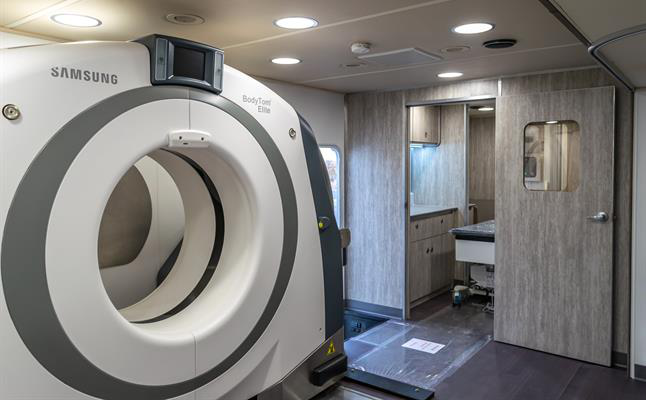Mobile CT improves access to lung cancer screening
By Abraham Kim, AuntMinnie.com staff writer
February 12, 2020 — A mobile CT unit in North Carolina is bringing lung cancer screening directly to the communities of high-risk individuals faced with geographic and socioeconomic barriers to standard screening programs, improving their access to screening services, according to a study slated for publication in the March issue of the Oncologist.
Several recent studies have uncovered disparities in the distribution of CT lung screening programs across the U.S. The consensus among these studies has been that minorities and individuals who live in rural areas, especially in southern states, have the least access to screening services despite often being at the greatest risk for lung cancer.
To address this discrepancy, researchers from the Levine Cancer Institute in Charlotte, NC, developed a mobile CT lung screening program targeting underserved and uninsured populations at high risk of lung cancer, notably heavy smokers affected by poverty, minimal health education, and geographic isolation. They launched the ongoing program in 2017 and published their initial results online in the Oncologist (November 26, 2019).
“When considering the underserved population, we knew that we had to do something big in the lung space for a population at very high risk for cancer. … We approached lung screening by bringing it to patients where they are, eliminating barriers related to transportation, finances, and stigma,” co-author Mellisa Wheeler told AuntMinnie.com. Wheeler is director of the institute’s disparities and outreach department.
The group’s mobile CT lung screening clinic features a 35-ft vehicle equipped with a portable, battery-powered CT scanner (BodyTom Elite, Samsung NeuroLogica), a pop-out wall that supports the scanner table, and a waiting and changing area. Besides the driver, a nurse program coordinator and CT technologist manage lung screening services inside the vehicle.

For their pilot study, the researchers described how they brought CT lung screening services directly to the communities of 550 individuals ages 55 to 64 years with limited access to hospital-based screening who met the National Lung Screening Trial (NLST) eligibility requirements. Roughly 70% of the participants were rural residents and 20% were African American.
By the end of the trial period, the mobile CT unit had identified lung cancer in 12 individuals (2.2% of all participants), including six (1.1%) with stage I or II non-small cell lung cancer (NSCLC). All those with lung cancer received appropriate surgical treatment or radiotherapy.
The mobile CT unit’s detection and treatment rate of 1.1% for NSCLC after initial screening matched outcomes from the NLST, even though the pilot study did not cover individuals older than 65 years, who tend to have the highest incidence of lung cancer.
Beyond simply screening for lung cancer, the mobile CT clinic offered a multitude of related services, including onsite tobacco-cessation counseling and therapy, educational sessions on Medicaid, and references to primary care providers in the community, among others.
“Reaching people in their communities can make all the difference, and this is the direction our society is headed — having care or services come to us, to our doorstep,” Wheeler said. “This is a different way of thinking about how we can care for underserved populations and make them feel welcome in the community.”
The success of the program has led to inquiries into the possibility of using the mobile CT unit to help manage natural disasters and epidemics, said David Webster, chief operating officer of Samsung Neurologica. Researchers from China are currently working on applying the mobile CT unit to facilitate coronavirus detection in sequestered areas.
